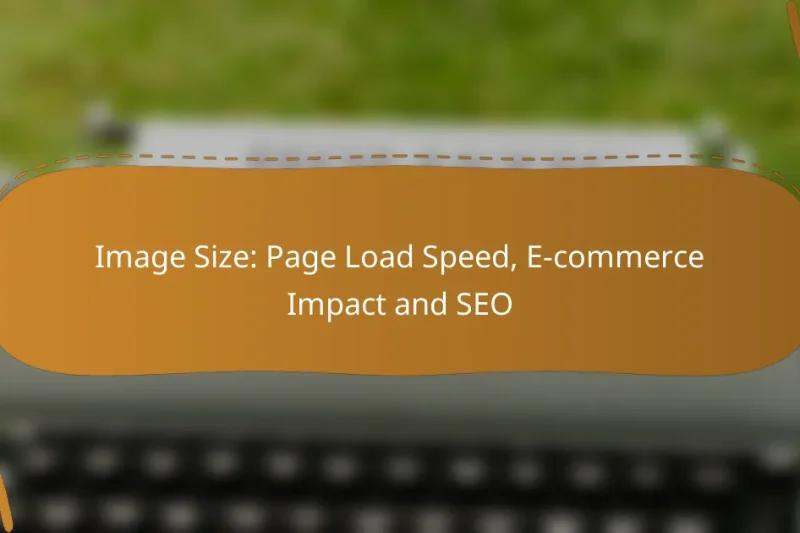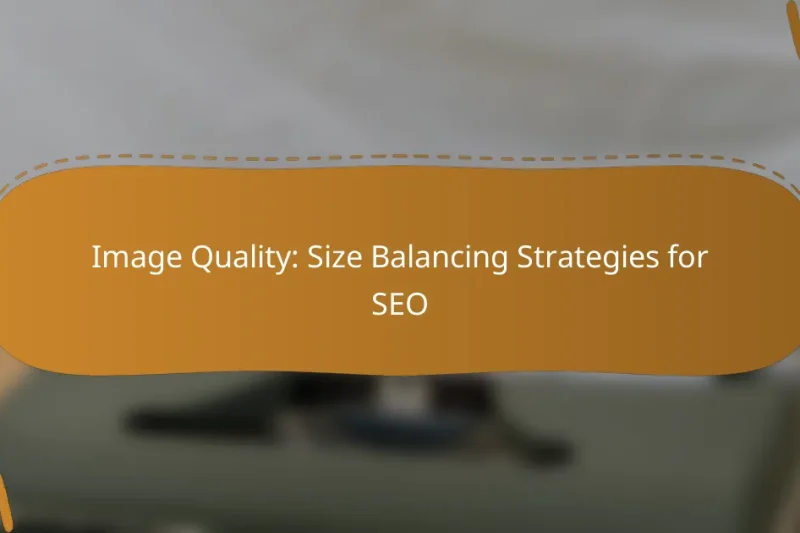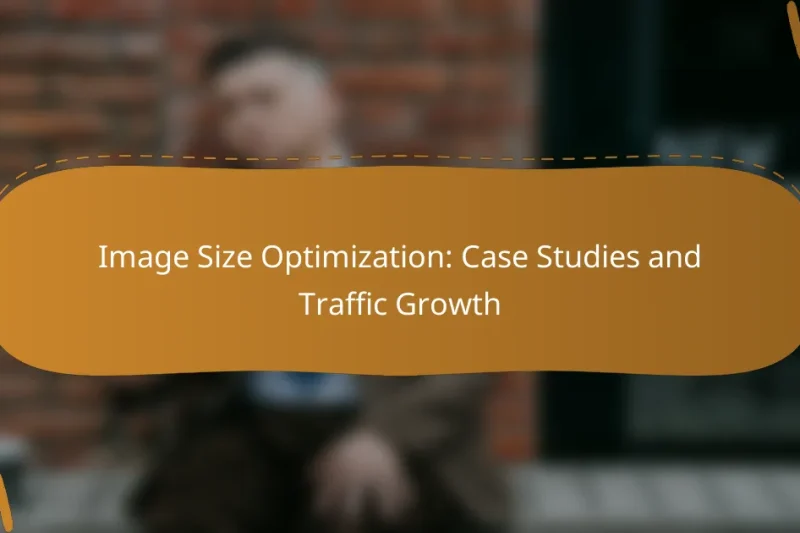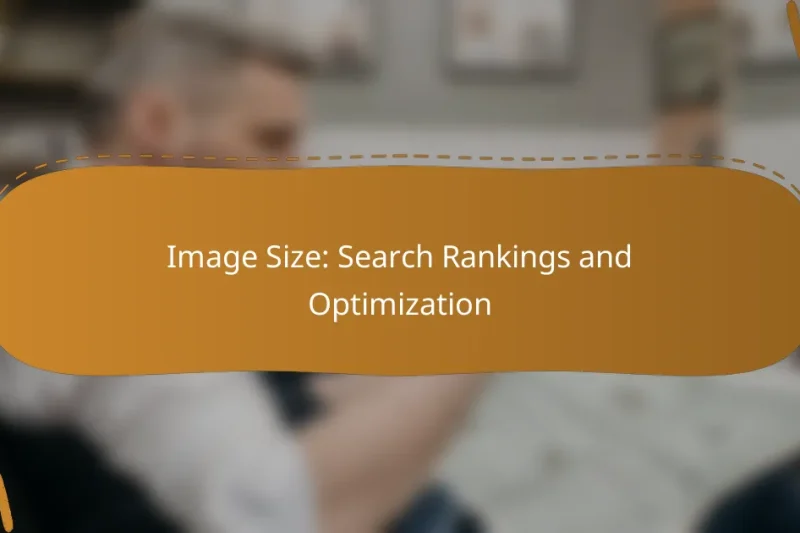Image size analysis tools play a crucial role in enhancing SEO performance by optimizing images for … Image Size Analysis Tools: SEO Improvement and PerformanceRead more
Impact of Image Size on SEO
Image size plays a crucial role in SEO by affecting page load speed, user experience, and mobile optimization. By optimizing images, websites can achieve faster loading times, enhance user engagement, and improve their rankings in search engine results.
Image Size: Page Load Speed, E-commerce Impact and SEO
Image size plays a crucial role in determining page load speed, especially in e-commerce, where fast … Image Size: Page Load Speed, E-commerce Impact and SEORead more
Image Quality: Size Balancing Strategies for SEO
Image size plays a crucial role in SEO, as it directly impacts load speed, user experience, … Image Quality: Size Balancing Strategies for SEORead more
Image Size Optimization: Case Studies and Traffic Growth
Image size optimization plays a crucial role in driving traffic growth by enhancing page load speeds, … Image Size Optimization: Case Studies and Traffic GrowthRead more
Image Size: Search Rankings and Optimization
Image size plays a crucial role in search rankings by affecting page load speed and user … Image Size: Search Rankings and OptimizationRead more
How does image size affect SEO performance?
Image size significantly impacts SEO performance by influencing page load speed, user experience, and mobile optimization. Optimizing images can lead to faster loading times, better engagement, and improved rankings in search engine results.
Impact on page load speed
Large images can slow down page load speed, which is a critical factor for SEO. A delay of even a few seconds can lead to higher bounce rates, as users are less likely to wait for a slow-loading page. Aim for images that are optimized to be under 100 KB whenever possible.
To improve load speed, consider using formats like JPEG for photographs and PNG for graphics with fewer colors. Tools like image compressors can help reduce file sizes without sacrificing quality.
Influence on user experience
The size of images affects user experience directly. When images load quickly and display correctly, users are more likely to stay on the site and engage with the content. Conversely, oversized images can frustrate users and lead to a negative perception of the website.
Ensure that images are responsive and adapt to different screen sizes. Using CSS techniques like ‘max-width: 100%’ can help maintain quality while ensuring images fit various devices.
Effect on mobile optimization
Mobile optimization is crucial, as a significant portion of web traffic comes from mobile devices. Large images can hinder mobile performance, leading to slow loading times and poor user experiences. Aim for images that are optimized for mobile, ideally under 50 KB.
Utilize responsive design principles, such as using the ‘srcset’ attribute in HTML, which allows browsers to select the appropriate image size based on the device’s screen resolution. This approach ensures that mobile users have a seamless experience without unnecessary data usage.
What are the best practices for image size in SEO?
Best practices for image size in SEO focus on optimizing images to enhance website performance and user experience. This includes using appropriate dimensions, selecting suitable file formats, and applying effective compression techniques to ensure fast loading times and improved search engine rankings.
Optimal dimensions for web images
Optimal dimensions for web images depend on the context in which they are used. For example, images for full-width banners should typically be around 1200 pixels wide, while thumbnails can be as small as 150 pixels. Maintaining the aspect ratio is crucial to avoid distortion.
Using responsive design principles can help ensure images display correctly on various devices. Aim for images that scale well, typically using CSS to adjust sizes based on screen resolution, which enhances both aesthetics and load times.
Recommended file formats for SEO
The recommended file formats for SEO include JPEG, PNG, and WebP. JPEG is ideal for photographs due to its balance of quality and file size, while PNG is better for images requiring transparency or sharp edges. WebP offers superior compression, resulting in smaller file sizes without sacrificing quality.
Choosing the right format can significantly impact loading speeds. For instance, using WebP can reduce image sizes by about 25-30% compared to JPEG, making it a strong choice for web optimization.
Compression techniques for images
Compression techniques are essential for reducing image file sizes without noticeable loss of quality. Lossy compression, which discards some data, is effective for photographs, while lossless compression retains all original data, making it suitable for graphics and logos.
Tools like TinyPNG or ImageOptim can help automate the compression process. Aim for a target file size under 100 KB for standard images to ensure quick loading times, especially on mobile devices. Regularly audit your images to maintain optimal performance.
How can image size be optimized for display advertising?
Optimizing image size for display advertising involves reducing file size while maintaining visual quality. This ensures faster loading times and better user experience, which can lead to improved ad performance.
Ad format specifications
Different display advertising platforms have specific image format requirements that dictate optimal sizes and dimensions. For instance, standard banner ads often require dimensions like 300×250 pixels or 728×90 pixels. Adhering to these specifications ensures that images render correctly across various devices and screen sizes.
Balancing quality and file size
Finding the right balance between image quality and file size is crucial for effective display advertising. Aim for a file size under 150 KB for faster loading, while maintaining a resolution that looks sharp on high-definition screens. Tools like compression can help reduce file size without significantly impacting quality.
Tools for image optimization
Several tools can assist in optimizing images for display ads. Software like Adobe Photoshop allows for advanced compression settings, while online tools such as TinyPNG or ImageOptim provide quick solutions for reducing file size. Regularly testing images on different platforms can help ensure they meet quality and performance standards.
What are the consequences of large image sizes on SEO?
Large image sizes can significantly hinder SEO performance by affecting page load speed and user experience. When images take too long to load, users are likely to leave the site, which can negatively impact search engine rankings.
Higher bounce rates
Large images can lead to higher bounce rates, as users may abandon a page if it takes too long to load. A slow-loading page can frustrate visitors, prompting them to seek faster alternatives. This behavior signals to search engines that the content may not be valuable, potentially harming its visibility.
To mitigate bounce rates, aim for image sizes under 100 KB when possible. Compressing images without sacrificing quality can enhance load times and keep users engaged.
Lower search engine rankings
Search engines prioritize fast-loading pages, and large images can slow down a site, leading to lower rankings. If a page’s loading speed falls below acceptable thresholds, it may not rank well in search results. This can reduce organic traffic and visibility.
Consider using tools like Google PageSpeed Insights to evaluate your page’s performance. Aim for a loading time of under three seconds to maintain competitive search engine rankings.
Increased bandwidth costs
Large images consume more bandwidth, which can lead to higher hosting costs, especially for sites with significant traffic. If your website exceeds bandwidth limits, you may incur additional charges or experience throttled speeds. This can further deter users from staying on your site.
To manage bandwidth costs, implement image optimization techniques such as using appropriate formats (like WebP) and employing lazy loading. These strategies can help reduce data usage while maintaining quality.
What tools can help analyze image size impact on SEO?
Several tools can effectively analyze how image size affects SEO, helping you optimize your website’s performance. These tools provide insights into loading times, image dimensions, and overall site speed, which are crucial for improving search engine rankings.
Google PageSpeed Insights
Google PageSpeed Insights is a widely used tool that evaluates the performance of your web pages, including the impact of image size on loading speed. It provides a score from 0 to 100, with recommendations on how to improve your site’s performance, such as optimizing images to reduce their file size.
When using PageSpeed Insights, focus on the suggestions related to image optimization. Aim for images that are compressed without significant loss of quality, ideally under 100 KB for standard web images, to enhance loading times and user experience.
GTmetrix
GTmetrix offers a comprehensive analysis of your website’s speed, including detailed reports on image sizes and their effects on load times. It breaks down the performance metrics and provides actionable recommendations, such as resizing or compressing large images.
Utilize GTmetrix to identify images that are larger than necessary. A good practice is to keep images under 200 KB for faster loading, especially on mobile devices, which can significantly improve your SEO performance.
Image optimization plugins
Image optimization plugins, such as Smush or ShortPixel, can automate the process of compressing and resizing images on your website. These tools integrate with popular content management systems like WordPress, making it easy to optimize images without manual intervention.
When selecting a plugin, look for features like bulk optimization and lazy loading, which can enhance site speed. Regularly check the plugin settings to ensure images remain optimized as you upload new content, maintaining optimal performance for SEO.
What emerging trends affect image size and SEO?
Emerging trends in image size and SEO emphasize the need for faster loading times and improved user experience. As search engines prioritize page speed and mobile optimization, optimizing image size becomes crucial for maintaining high search rankings.
AI-driven image optimization
AI-driven image optimization uses algorithms to automatically adjust image size and quality based on the context of use. This technology analyzes various factors, such as device type and network speed, to deliver the most suitable image version, enhancing both performance and user experience.
For instance, AI tools can compress images without significant loss of quality, reducing file sizes from several megabytes to just a few hundred kilobytes. This not only speeds up page load times but also improves SEO rankings, as search engines favor sites that load quickly.
When implementing AI-driven optimization, consider using tools like Google’s Image Optimization API or Adobe’s Sensei. Regularly monitor your website’s performance metrics to ensure that image optimization aligns with SEO goals, avoiding pitfalls like over-compression that could degrade image quality.




